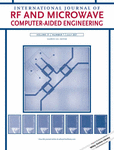A miniaturized three-dimensional log periodic Koch-dipole array antenna using T-shaped top loading
Funding information: National Natural Science Foundation of China, Grant/Award Number: 61701326; Fundamental Research Funds for the Central Universities, Grant/Award Number: YJ201813; Sichuan Science and Technology Program, Grant/Award Number: 2019YJ0100
Abstract
A log periodic dipole array antenna (LPDA) is miniaturized by using top loading. The Koch dipole further helps to shrink the antenna size. Different from the traditional LPDA that features a planar structure, the proposed log periodic Koch-dipole array (LPKDA) adopts two identical pairs of top-loaded Koch-dipoles that deploy orthogonally along the feed line. This results in a tree-like three-dimensional antenna geometry, which introduces one extra dimension of freedom for antenna designers. The influence of the top-loading on antenna's impedance bandwidth is studied under the Wheeler and Chu's limit. The characteristic of the Koch-dipole is analyzed. Taking the advantage of 3D printing technology to fabricate complex models, the proposed LPKDA is printed by selective laser melting using aluminum alloy. The simulated −10-dB bandwidth is 117.4% (0.91-3.54 GHz) The LPKDA has the average gain of 5.3 dBi over the 1 to 3.5 GHz impedance bandwidth in measurement. Radiation patterns agree well in simulation and measurement. Compared with conventional LPDA of the same impedance bandwidth, the proposed LPKDA features 42%-dimensional reduction. This letter proves the feasibility of antenna optimization by using both innovative design method and advanced fabrication process.
Open Research
DATA AVAILABILITY STATEMENT
Data sharing is not applicable to this article as no new data were created or analyzed in this study.




